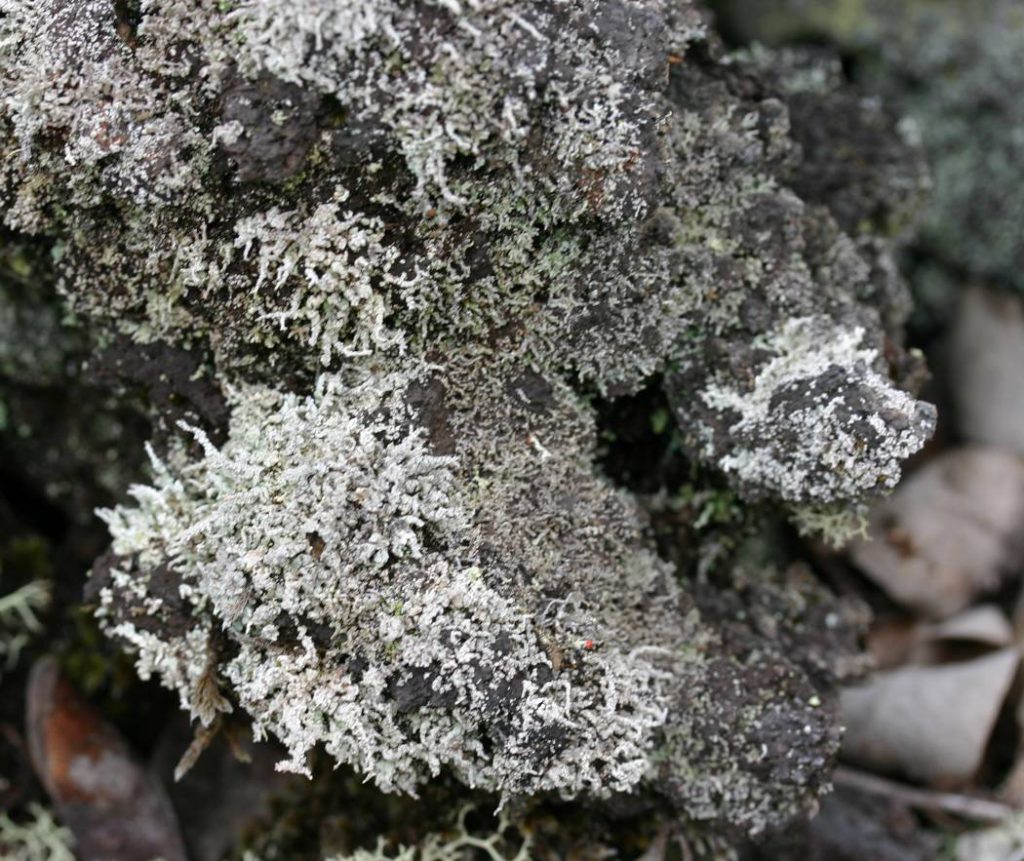VOLCANO WATCH: Freddy Fungus and Annie Alga Versus the Volcano

This nitrogen-fixing lichen, Stereocaulon vulcani, is frequently abundant on`ā`ā lava flows on the Island of Hawai’i, particularly in wet environments. Photo courtesy of Tim Tunison.
The saying “Annie alga and Freddy fungus took a lichen to each other” can invoke groans or giggles from students of environmental science. This mnemonic helps us remember that a lichen is formed by two (or sometimes three) organisms from different biological kingdoms living in a mutually beneficial relationship with each other.
In the case of lichens, Annie (algae) can photosynthesize and provide nutrients for Freddy (fungi). In turn, Freddy provides shelter so that Annie can survive in harsh conditions in which algae would not otherwise thrive.
Lichens are tough organisms adapted to life in extreme environments. They can survive heat, cold, drought or an abundance of rain. They live on bare soil, tree bark, woody debris, and rocks, as well as on rusty metal, plastic, tombstones and old abandoned cars.
Lichens can create a furry appearance on rock surfaces, look similar to crusty paint chips, or masquerade as plants with leafy or shrubby forms. They frequently grow in habitats not occupied by more dominant seed plants.
On the Island of Hawai‘i, lichens are important colonists of young lava flows, particularly `ā`ā lava. Lichens contribute to the accumulation of soil by supplying organic matter and nitrogen-fixing lichens may add nitrogen to the environment. This helps set the stage for future development of plant communities.
Certain types of lichens found in Hawai‘i are also important pioneers of young volcanic landscapes in other parts of the world, including the Caribbean, the Azores, La Reunion Island, the Canary Islands and Africa.
Although able to tolerate environmental extremes, some lichens are quite sensitive to air pollution. Lichens retain the chemicals they absorb from air and water over periods of tens to hundreds of years. Since the mid-19th century, when the industrial revolution began producing increased levels of air pollution, observers have noted the scarcity of lichens growing in urban settings.
Lichen species differ in their sensitivity to air pollution, and the presence or absence of different lichens in an area has been used to map concentrations of pollutants. Hundreds of studies around the world have used lichens to assess air quality.
Lichens are particularly sensitive to sulfur dioxide gas (SO2), a pollutant produced by coal- and oil-burning power plants, industrial processes, automobiles, and volcanoes, such as those here in Hawaiʻi. SO2 dissolved in water is acidic, is readily absorbed by lichens, and damages Annie alga’s chlorophyll and ability to photosynthesize.
Without sugar, which is produced through photosynthesis and fuels the lichen’s life, the organism will fail to thrive and may eventually die. For some species, SO2 also inhibits the ability of lichens to reproduce.
When Kīlauea Volcano’s summit eruption began in 2008, huge amounts of SO2 were released and lichens in the area suffered. One might expect that the significant decline in emissions measured since 2008 could be reflected in a partial recovery of these lichens. Astute observers may be able to detect positive changes in the lichen population over time.
Lichens can also accumulate trace elements present in volcanic emissions. Studies at Kīlauea, as well as at Mount Etna and Vulcano in Italy, show that in downwind areas heavily impacted by volcanic plumes, lichens contain a higher concentration of volcanic pollutants. These include fluoride, bromide, and metals, such as copper, lead, zinc, gold, mercury and antimony.
Even under especially adverse conditions, lichens can grow in pockets of protected areas. For example, trees, shrubbery and walls can provide shelter that encourages lichen growth adjacent to these areas.
Heavily vegetated areas can intercept SO2, effectively “scrubbing” the air to provide a microclimate that is more hospitable to lichens. Interestingly, some Hawai‘i residents have noted that they are less irritated by volcanic pollution, or vog, in heavily forested areas than in adjacent exposed areas.
Hardy lichens are ubiquitous in our environment. They play a critical role in populating new lava flows and help pave the way for the development of complex ecosystems. Tough as they are, lichens can be extremely sensitive to contaminants in our environment and serve as indicators of both anthropogenic and volcanic pollution.
For additional information, see the US Forest Service National Lichens and Air Quality Database and Clearinghouse.
Volcano Activity Updates
Kīlauea continues to erupt at its summit and East Rift Zone. During the past week, the summit lava lake level varied between about 24 m and 35 m (79–115 feet) below the vent rim within Halema‘uma‘u Crater. On the East Rift Zone, the “61g” flow continued to advance to the southeast, and, as of July 12, 2016, the leading tip of the flow was about 940 m (.6 mi) from the ocean. The lava flow does not pose an immediate threat to nearby communities.
At Mauna Loa, rates of deformation and seismicity remain above long-term background levels. During the past week, HVO seismometers recorded short bursts of earthquakes at depths of about 5 to 11 km (3–7 miles) beneath the upper west and north flanks of the volcano.
Such activity has been detected before and is likely a response of the volcano to stresses related to slow accumulation of magma in the summit and upper Southwest Rift Zone magma storage complex.
Ongoing addition of magma to this region is supported by ground surface deformation (inflation) measured by Global Positioning System instrumentation across the volcano, as well as by satellite radar (InSAR).
One earthquake was reported felt on the Island of Hawaiʻi in the past week. On Friday, July 8, 2016, at 9:11 a.m., HST, a magnitude-3.5 earthquake occurred 10.8 km (6.7 mi) west of Kalapana at a depth of 8.0 km (5 miles).
Volcano Watch is a weekly article and activity update written by U.S. Geological Survey Hawaiian Volcano Observatory scientists and affiliates.
Call for summary updates at (808) 967-8862 (Kīlauea) or (808) 967-8866 (Mauna Loa); email questions to [email protected].













